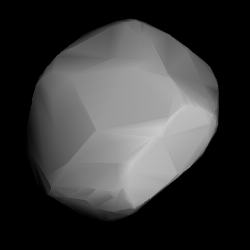Hypatia (minor planet designation: 238 Hypatia) is a very large main-belt asteroid that was discovered by Russian astronomer Viktor Knorre on July 1, 1884, in Berlin. It was the third of his four asteroid discoveries. The name was given in honour of philosopher Hypatia of Alexandria. Based upon the spectrum, it is classified as a C-type asteroid[4] and is probably composed of primitive carbonaceous material. Like many asteroids of this type, its surface is very dark in colour.
 3D model based on lightcurve data | |
| Discovery | |
|---|---|
| Discovered by | Viktor Knorre |
| Discovery date | 1 July 1884 |
| Designations | |
| (238) Hypatia | |
| Pronunciation | /hɪˈpeɪʃiə/[1] |
Named after | Hypatia |
| A884 NA, 1947 HA | |
| Main belt | |
| Adjectives | Hypatian |
| Orbital characteristics[2] | |
| Epoch 31 July 2016 (JD 2457600.5) | |
| Uncertainty parameter 0 | |
| Observation arc | 124.07 yr (45318 d) |
| Aphelion | 3.1652 AU (473.51 Gm) |
| Perihelion | 2.6514 AU (396.64 Gm) |
| 2.9083 AU (435.08 Gm) | |
| Eccentricity | 0.088335 |
| 4.96 yr (1811.5 d) | |
Average orbital speed | 17.47 km/s |
| 170.00° | |
| 0° 11m 55.392s / day | |
| Inclination | 12.413° |
| 183.89° | |
| 210.750° | |
| Physical characteristics | |
| Dimensions | 148.49±3.6 km[2] 146.13 ± 2.66 km[3] |
| Mass | (4.90 ± 1.70) × 1018 kg[3] |
Mean density | 2.99 ± 1.05 g/cm3[3] |
| 8.8749 h (0.36979 d) | |
| 0.0428±0.002 | |
| C | |
| 8.18 | |

Photometric observations of this asteroid at the European Southern Observatory in 1981 gave a light curve with a period of 8.9 ± 0.1 hours and a brightness variation of 0.12 in magnitude.[5] Stellar occultation events were observed for this asteroid during 2001 and 2005. The resulting chords provided cross-section diameter estimates of 146.5 and 145.3 km, respectively.[6]
References edit
- ^ "Hypatia". Lexico UK English Dictionary. Oxford University Press. Archived from the original on March 23, 2020.
- ^ a b Yeomans, Donald K., "238 Hypatia", JPL Small-Body Database Browser, NASA Jet Propulsion Laboratory, retrieved 12 May 2016.
- ^ a b c Carry, B. (December 2012), "Density of asteroids", Planetary and Space Science, 73 (1): 98–118, arXiv:1203.4336, Bibcode:2012P&SS...73...98C, doi:10.1016/j.pss.2012.03.009. See Table 1.
- ^ Piironen, J.; et al. (March 1998), "Physical studies of asteroids. XXXII. Rotation periods and UBVRI-colours for selected asteroids", Astronomy and Astrophysics Supplement, 128 (3): 525–540, Bibcode:1998A&AS..128..525P, doi:10.1051/aas:1998393.
- ^ Schober, H. J. (January 1983), "Rotation periods and lightcurves of the asteroids 136 Austria and 238 Hypatia", Astronomy and Astrophysics, 117 (2): 362–364, Bibcode:1983A&A...117..362S.
- ^ Shevchenko, Vasilij G.; Tedesco, Edward F. (September 2006), "Asteroid albedos deduced from stellar occultations", Icarus, 184 (1): 211–220, Bibcode:2006Icar..184..211S, doi:10.1016/j.icarus.2006.04.006.
External links edit
- The Asteroid Orbital Elements Database
- Minor Planet Discovery Circumstances
- Asteroid Lightcurve Data File
- 238 Hypatia at AstDyS-2, Asteroids—Dynamic Site
- 238 Hypatia at the JPL Small-Body Database